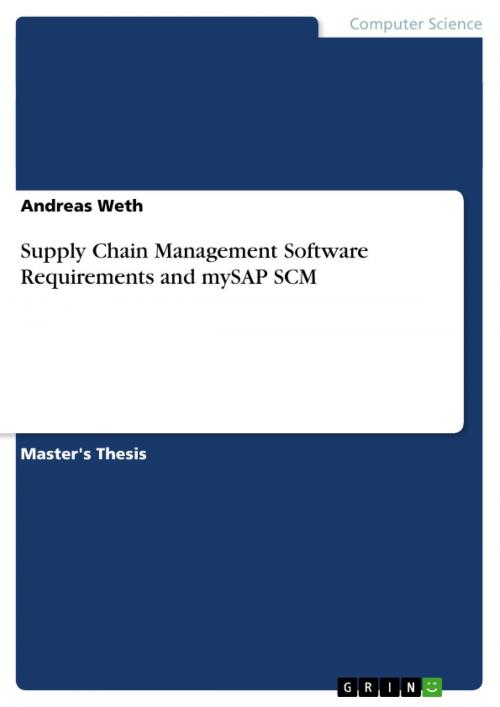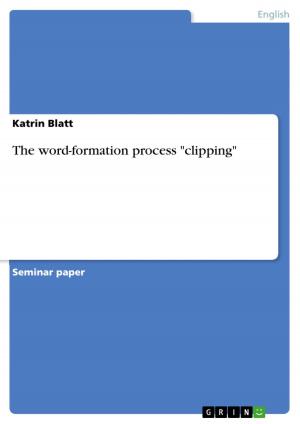Supply Chain Management Software Requirements and mySAP SCM
Nonfiction, Computers, Advanced Computing, Computer Science| Author: | Andreas Weth | ISBN: | 9783638408332 |
| Publisher: | GRIN Publishing | Publication: | August 12, 2005 |
| Imprint: | GRIN Publishing | Language: | English |
| Author: | Andreas Weth |
| ISBN: | 9783638408332 |
| Publisher: | GRIN Publishing |
| Publication: | August 12, 2005 |
| Imprint: | GRIN Publishing |
| Language: | English |
Master's Thesis from the year 2005 in the subject Computer Science - Commercial Information Technology, grade: 1,7, University of Auckland (Faculty of Computing), course: Master of Computing, 83 entries in the bibliography, language: English, abstract: Supply chain management (SCM) offers business benefits but is a difficult concept to master without the right software support. This dissertation is aimed at academic and IT professionals and SCM decision makers or consultants as it provides insights into SCM software and the leading concepts behind it. A qualitative approach was chosen for answering the research questions which focus on general SCM software principles but also enquire benefits, functionalities and the software architecture of SAP's SCM 4.1 solution. In addition to that, the differences between what decision makers request and what mySAP SCM 4.1 offers are addressed with the research questions. To answer these research questions, the structure of the dissertation contains a general introduction to SCM software and includes a SCM software market overview. After this part, one major part of the dissertation contains an analysis of the dominant SCM software solution mySAP SCM (Release 4.1). The examination of mySAP SCM 4.1 focuses first on technological aspects (software architecture, technological platform and programming language) before the business benefits and functionalities of this SCM software are examined. After that, the functionalities, business benefits and the architecture of mySAP SCM 4.1 are compared with the SCM software requirements obtained from ten SCM professionals from different industries (automotive, logistics, retail, consumer packaged goods, consulting and education). The analysis of the requirements from SCM decision makers (gathered using a questionnaire) shows that an increase in SCM transparency and a reduction of SCM costs were the main requirements articulated by decision makers. The comparison of the questionnaire with the functionalities, business benefits and the architecture of mySAP SCM 4.1 then illustrates that these requirements can be realised with SAP's SCM 4.1. Concerning future research in the field of SCM software, it was found out that SCM software will be influenced by the following developments: increasing globalisation together with the internationalisation of SCM, the trend of services oriented architecture and the integration of corporate information systems. Keywords: Supply Chain Management (SCM), Supply Chain Management Software, mySAP SCM 4.1, Supply Chain Operations Reference (SCOR) Model, Enterprise Services Architecture (ESA), Netweaver
Master's Thesis from the year 2005 in the subject Computer Science - Commercial Information Technology, grade: 1,7, University of Auckland (Faculty of Computing), course: Master of Computing, 83 entries in the bibliography, language: English, abstract: Supply chain management (SCM) offers business benefits but is a difficult concept to master without the right software support. This dissertation is aimed at academic and IT professionals and SCM decision makers or consultants as it provides insights into SCM software and the leading concepts behind it. A qualitative approach was chosen for answering the research questions which focus on general SCM software principles but also enquire benefits, functionalities and the software architecture of SAP's SCM 4.1 solution. In addition to that, the differences between what decision makers request and what mySAP SCM 4.1 offers are addressed with the research questions. To answer these research questions, the structure of the dissertation contains a general introduction to SCM software and includes a SCM software market overview. After this part, one major part of the dissertation contains an analysis of the dominant SCM software solution mySAP SCM (Release 4.1). The examination of mySAP SCM 4.1 focuses first on technological aspects (software architecture, technological platform and programming language) before the business benefits and functionalities of this SCM software are examined. After that, the functionalities, business benefits and the architecture of mySAP SCM 4.1 are compared with the SCM software requirements obtained from ten SCM professionals from different industries (automotive, logistics, retail, consumer packaged goods, consulting and education). The analysis of the requirements from SCM decision makers (gathered using a questionnaire) shows that an increase in SCM transparency and a reduction of SCM costs were the main requirements articulated by decision makers. The comparison of the questionnaire with the functionalities, business benefits and the architecture of mySAP SCM 4.1 then illustrates that these requirements can be realised with SAP's SCM 4.1. Concerning future research in the field of SCM software, it was found out that SCM software will be influenced by the following developments: increasing globalisation together with the internationalisation of SCM, the trend of services oriented architecture and the integration of corporate information systems. Keywords: Supply Chain Management (SCM), Supply Chain Management Software, mySAP SCM 4.1, Supply Chain Operations Reference (SCOR) Model, Enterprise Services Architecture (ESA), Netweaver















